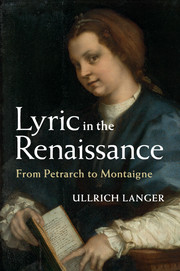Book contents
- Lyric in the Renaissance
- Lyric in the Renaissance
- Copyright page
- Dedication
- Contents
- Book part
- Chapter 1 Introduction
- Chapter 2 Petrarch and the existential singular
- Chapter 3 Minimal lost worlds
- Chapter 4 Ronsard’s singular erotic reciprocity(Les Amours de Cassandre)
- Chapter 5 Singularity as emptiness
- Chapter 6 Montaigne and his “sublime” lyric
- Chapter 7 Conclusion
- Notes
- Bibliography
- Index
- References
Bibliography
Published online by Cambridge University Press: 05 July 2015
- Lyric in the Renaissance
- Lyric in the Renaissance
- Copyright page
- Dedication
- Contents
- Book part
- Chapter 1 Introduction
- Chapter 2 Petrarch and the existential singular
- Chapter 3 Minimal lost worlds
- Chapter 4 Ronsard’s singular erotic reciprocity(Les Amours de Cassandre)
- Chapter 5 Singularity as emptiness
- Chapter 6 Montaigne and his “sublime” lyric
- Chapter 7 Conclusion
- Notes
- Bibliography
- Index
- References
- Type
- Chapter
- Information
- Lyric in the RenaissanceFrom Petrarch to Montaigne, pp. 201 - 213Publisher: Cambridge University PressPrint publication year: 2015



